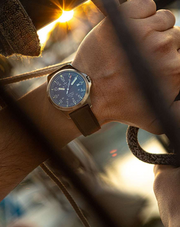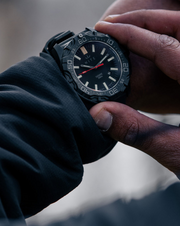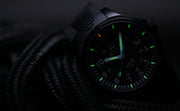Key Takeaways
- Swiss quartz technology delivers 15-22 times better accuracy than mechanical watches in field conditions
- Temperature stability - quartz maintains precision whilst automatic movements can gain/lose 20 seconds daily in extreme conditions
- Minimal maintenance - quartz requires only battery replacement every 4-5 years versus costly annual servicing for mechanical movements
- Superior magnetic resistance - Swiss quartz withstands electromagnetic interference that permanently affects automatic watch mechanisms
- Extended battery life - 4-5 years continuous operation versus 40-72 hours for automatic movements
- Professional reliability - NITE's MX10 earned NATO certification and UK Special Forces adoption for proven field performance
- Cost efficiency - total ownership costs favour Swiss quartz by over £2,400 across ten years
Movement Comparison: Durability Under Pressure
When professionals stake their careers on timing accuracy, the choice becomes clear: Swiss quartz technology provides the unwavering reliability that mechanical watches simply cannot match in demanding outdoor applications.
While automatic watches offer traditional craftsmanship and the romance of purely mechanical operation, their complex mechanical systems introduce variables that compromise accuracy when conditions become challenging. Swiss quartz movements utilise a 32,768 Hz quartz crystal oscillation, providing an incredibly stable timing reference that remains consistent regardless of environmental conditions or wearing patterns.
Our Swiss-made Ronda movements demonstrate this reliability advantage through proven performance in tactical applications. When the MX10 was selected for UK Special Forces deployment, it wasn't about marketing appeal, it was about operational necessity where timing accuracy could determine mission success.
| Specification | Swiss Ronda 715 (Quartz) | Standard Automatic Movement |
|---|---|---|
| Monthly Accuracy | ±20 seconds | ±150 to ±450 seconds |
| Daily Accuracy | ±0.67 seconds | ±5 to ±15 seconds |
| Power Reserve | 60 months (battery) | 40-72 hours (kinetic) |
| Temperature Stability | Excellent (compensated crystal) | Variable (±20 sec/day extremes) |
| Magnetic Resistance | Up to 18.8 Oe | Requires demagnetising at 60 gauss |
| Shock Resistance | NIHS 91-10 certified | Delicate components vulnerable |
| Service Interval | Battery replacement (4-5 years) | Full service (3-5 years, £200-400) |
| Operational Readiness | Always ready | Stops if unworn 40-72 hours |
Precision Testing: The Numbers Behind Watch Reliability
What we've learned from supplying tactical professionals is that precision isn't academic, it's operational. Our Swiss Ronda 715 movements maintain accuracy within ±20 seconds per month, whilst even high-quality mechanical watch movements can deviate by ±150 to ±450 seconds monthly. That's a 15-22 times improvement in timekeeping precision when outdoor reliability matters most.
Daily accuracy reveals why professionals choose Swiss quartz technology. COSC-certified automatic movements, considered the mechanical gold standard, still drift ±5 seconds daily. Our Swiss quartz movements achieve ±0.67 seconds daily accuracy, maintaining virtually perfect timekeeping throughout extended operations.
From our experience with emergency responders and expedition professionals, this precision difference becomes critical when coordinating with teams, timing procedures, or maintaining operational schedules where being off by minutes rather than seconds creates genuine problems.
Environmental Durability: Real-World Performance
Outdoor conditions expose the fundamental differences between these watch movements. Temperature fluctuations alone tell the story, automatic timepieces can gain or lose 20 seconds daily during extreme weather, whilst Swiss quartz technology maintains stability across massive temperature ranges.
Temperature Resistance That Actually Works
Mechanical movements suffer from thermal expansion and contraction affecting the balance wheel and hairspring dimensions, causing timing variations that compound over extended periods. Swiss quartz movements utilise temperature-compensated crystals that maintain consistent oscillation regardless of environmental conditions, providing consistent performance from arctic operations to desert environments where mechanical watches would require constant adjustment.
Magnetic Field Immunity
Modern operational environments present serious challenges for automatic timepieces. Vehicle engines, electronic equipment, and industrial machinery generate magnetic fields that permanently affect mechanical watch accuracy, often without the user realising their timepiece has been compromised. We've seen mechanical watches drift by minutes per day after exposure to common electromagnetic sources.
Our Swiss quartz movements demonstrate superior magnetic resistance, with NITE's Ronda movements withstanding magnetic fields up to 18.8 Oe without affecting timekeeping accuracy. This resistance proves essential for professionals working around electronic equipment where automatic watches would gradually become unreliable without obvious symptoms.
Battery Life vs Power Reserve: Operational Consistency
Mechanical watches depend entirely on regular wearing or manual winding, with typical 40-72 hour reserves requiring constant attention. Our Swiss quartz technology provides 4-5 years of continuous operation from a single battery replacement, with the Ronda 715 movement offering 60-month battery life regardless of usage patterns, critical for backup equipment or rotating duty assignments where reliability cannot be compromised.
Shock and Impact Durability
Automatic movements contain delicate components, particularly balance wheels and escapements, that suffer damage from impacts and vibration, limiting their suitability for demanding operational environments. Our Swiss quartz movements feature fewer moving parts and more robust construction, with NITE watches incorporating shock-resistant Swiss movements meeting NIHS 91-10 standards for reliable operation despite impacts that would compromise automatic mechanisms.
Service Requirements: Maintenance Readiness
Equipment reliability extends beyond performance to service requirements. Mechanical watches require comprehensive servicing every 3-5 years, involving complete movement disassembly, cleaning, lubrication, and adjustment. These services cost £200-400 for standard movements, with complex models exceeding £1,000, significant for equipment procurement budgets.

Reduced maintenance requirements mean outdoor equipment remains mission-ready with minimal intervention, maintaining chronometer-level accuracy throughout the service interval without operational downtime for servicing.
Military and Tactical Heritage
NITE's MX10 field watch earned NATO certification and deployment with UK Special Forces because Swiss quartz reliability meets military operational requirements that automatic movements cannot achieve. Military operations demand timing precision for coordination, navigation, and tactical synchronisation where chronometer-level accuracy must remain consistent regardless of conditions.

The tritium illumination technology combined with Swiss quartz movements creates timepieces that perform reliably in complete darkness without requiring external charging, essential capabilities that complement the movement's inherent reliability for tactical applications.
Professional and Tactical Watch Applications
Emergency responders and expedition professionals require timepieces that function reliably regardless of conditions. Medical procedures, rescue operations, and emergency coordination depend on accurate timing where delays or miscommunication can have serious consequences.
For outdoor professionals and expedition leaders, extended operations present harsh testing conditions. Temperature extremes, altitude changes, and physical demands characterise environments where reliable timing proves essential for safety and navigation, making Swiss quartz technology the logical choice for field reliability.
Looking for the ultimate military watch buying guide? Professional users consistently choose quartz movements when operational performance takes priority over traditional mechanical craftsmanship.
Cost-Benefit Analysis: The Complete Picture
The financial advantage of Swiss quartz extends beyond initial purchase price to encompass total ownership costs. Swiss quartz watches provide professional-grade reliability at a fraction of mechanical watch operating costs, with consistent accuracy eliminating the need for backup timepieces whilst minimal maintenance requirements reduce long-term ownership burden significantly.

Cost-Benefit Analysis: The Complete Picture
The financial advantage of Swiss quartz extends beyond initial purchase price to encompass total ownership costs. Swiss quartz watches provide professional-grade reliability at a fraction of automatic watch operating costs, with consistent accuracy eliminating the need for backup timepieces whilst minimal maintenance requirements reduce long-term ownership burden significantly.
The Final Verdict: Performance Over Tradition
For professionals who depend on accurate timing, Swiss quartz technology represents the superior choice through demonstrable advantages in precision, durability, and operational cost. The 15-22 times improvement in timekeeping precision, superior environmental stability, and minimal service requirements create compelling reasons to choose Swiss quartz over mechanical movements.
While automatic timepieces offer traditional craftsmanship and horological heritage, professional applications demand performance over sentiment. Our Swiss Ronda movements deliver consistent reliability that tactical users require, eliminating the variables that compromise mechanical watch performance in demanding conditions.
This superiority in outdoor reliability makes Swiss quartz technology the logical choice for anyone who prioritises performance over tradition, ensuring their timepiece supports rather than compromises their operational effectiveness.
Ready to explore NITE's proven Swiss quartz watch collections? Discover why professionals worldwide choose reliability that never lets them down when it matters most.
Frequently Asked Questions
How accurate are Swiss quartz movements compared to automatic watches? Swiss quartz movements like those in NITE watches maintain accuracy within ±20 seconds per month, whilst automatic watches typically deviate by ±150 to ±450 seconds monthly. This represents a 15-22 times improvement in timekeeping precision.
Do environmental conditions affect quartz watch accuracy? Swiss quartz movements demonstrate superior environmental stability. Whilst automatic watches can gain or lose 20 seconds daily during temperature extremes, Swiss quartz movements maintain consistent accuracy across extreme temperature ranges using temperature-compensated crystals.
What maintenance do Swiss quartz watches require? Swiss quartz movements require only battery replacement every 4-5 years. This contrasts with automatic watches requiring comprehensive servicing every 3-5 years costing £200-400 or more.
Are quartz watches suitable for military applications? Yes, NITE's MX10 Swiss quartz field watch earned NATO certification and was supplied to UK Special Forces specifically because Swiss quartz reliability meets military operational requirements that automatic movements cannot achieve.
How do magnetic fields affect different watch movements? Automatic movements require demagnetising after exposure to magnetic fields as weak as 60 gauss. Swiss quartz movements resist magnetic fields up to 18.8 Oe without affecting accuracy, making them suitable for environments with electronic equipment.












